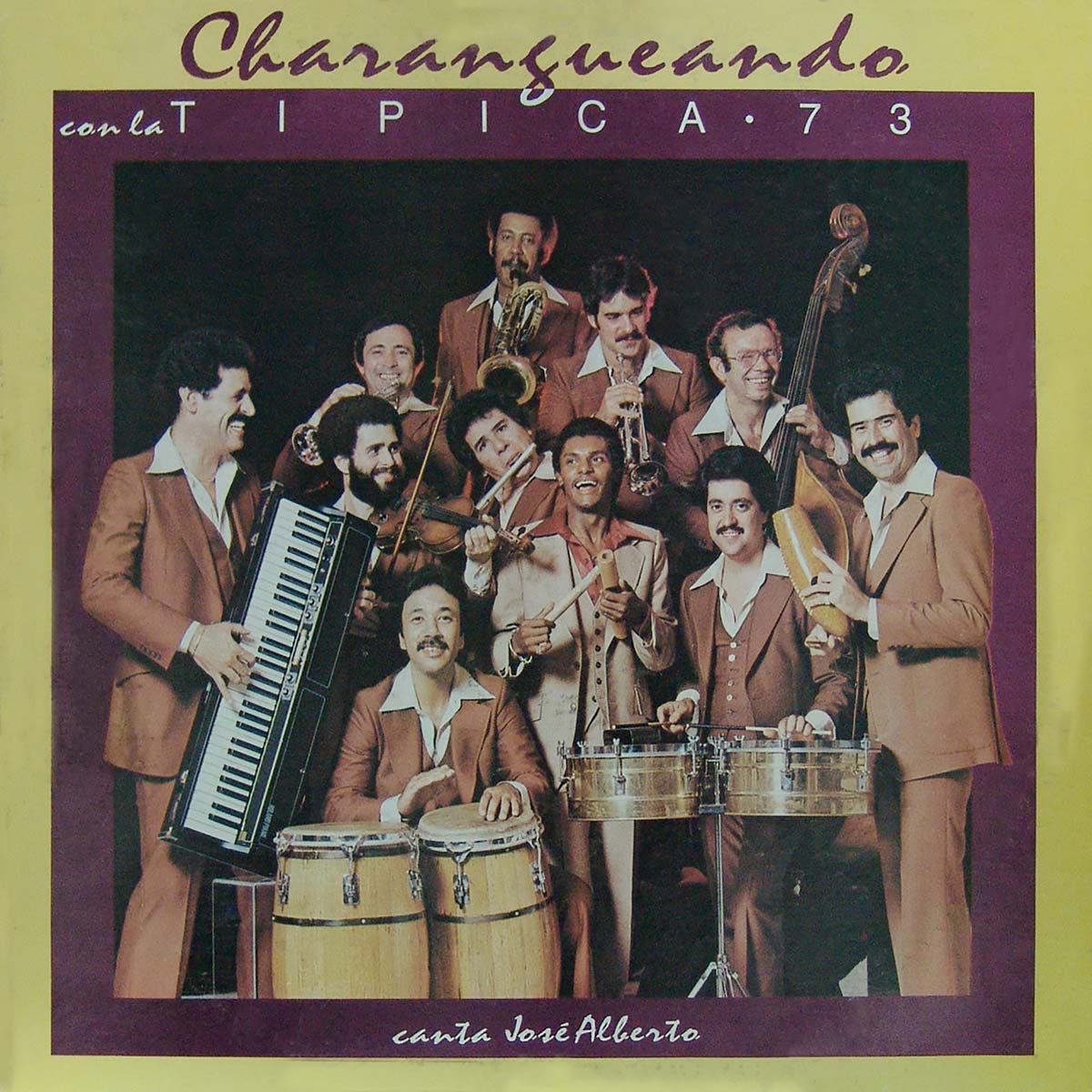
INTO THE 80’S TIPICA 73 This album marks the end of a musical era. Despite the fact that Típica 73 continued to perform in various combinations, this was the last studio recording that the band made. On this recording, a number of interesting phenomena foreshadow the future of this musical group. First, Típica continued to record songs by Cuban composers, popularized by bands still based in Cuba. Sonny Bravo actually recorded Elmer Ferreira playing “Tula” on his portable tape recorder when Típica 73 visited Cuba.
The band also saw Los Reyes del ‘73 perform “Llévatela” in Cuba on the same trip. Second, José Alberto, who would go on to enjoy a solid solo career during the 1980s and 1990s, took a leadership role in choosing a few tunes, one of which was a merengue. This is somewhat ironic because in the 1980s, the Spanish Caribbean music scene in New York would shift from salsa to merengue and then ultimately back to salsa romántica (where the focus has remained on the singer not the musicians). Third, the band brought in numerous special guests to add traditional textures and flavors to the arrangements. Sonny Bravo was going for a full Machito-like sound on tunes like “Chachagüere” and “Tula”. Similarly, Cortijo, Kako and Yomo Toro add el sabor boricua to “A Pico Y Pala”. In his original liner notes for this recording, Tony Sabournin wrote that Típica 73 was always [moving] forward [and] touching all the bases: Típico…avant-garde… jazzy. In 1982, Sabournin likened Típica’s progressive musical outlook to the spirit of the 80s, but unfortunately the 1980s weren’t as progressive. Today in 2006, the Spanish Caribbean music scene is dominated by reggaetón, and Típica 73 makes very few live appearances.
When economics and the pendulum of musical tastes swings back toward solid musicianship, arranging, improvization and group performance, the musical legacy of Típica 73 will forever stand as a musical beacon for future generations. “Fascinación”. Oscar Hernández’s jazzy arrangement showcases the band’s unique instrumentation and approach. Bravo turns in a great piano solo and the band swings throughout. “Tula “.This big band songo chart (with a big coro, too) blasts into the stratosphere with Sonny Bravo’s modern arrangement and Alfredo del la Fé’s wild wah-wah and echo-laden solo. Taco’s flute solo brings it all back home before the band takes it out. “El Humito”. As Canario says, La Típica 73 en merengada, but there’s much more to it. After the bulk of the arrangement, the band breaks into palos, a Dominican folkloric music that has only recently gained popularity in the last few years. It doesn’t get any more visionary than this. “Chachagüere”. Sonny Bravo’s arrangement is a textbook example of swing and harmony while the band’s execution is a lesson in musical taste and performance.
Listen to how Alfredo de la Fé’s violin locks in with the piano and then with the horns. “La Igualdad”. Típica 73 stayed away from overtly discussing politics in its music choosing to let the music do the talking, but “La Igualdad” offers a rare political statement. José Febles is one of Sonny Bravo’s favorite arrangers and it’s easy to hear why. “Gladys y Manolo”. Eddy Martínez’s arrangement hints at danzón and moves to songo taking advantage of all of the colors in the band, blurring the lines between charanga, conjunto and orquesta. Nicky Marrero turns in a beautiful solo, bien típico. “A Pico Y Pala”. Bomba puertorriqueña à la Típica 73. Who better to add to the mix than Cortijo, Kako and Yomo Toro? René López plays a short but sweet trumpet solo that shows his unique voice. Notice how the drummers respond to him. “Llévatela”. This arrangement by Luís Perico Ortiz offers another showcase for the whole band. Before his spacey solo, Alfredo de la Fé’s violin works like a tres when playing guajeos with Sonny Bravo. The major-key montuno modulates briefly to a minor key that propels the band to another level of swing. Listen carefully for Néstor Sánchez’s high voice in the two-part harmony of the melody.
Credits: Sonny Bravo, John Rodríguez Jr. – Leaders José Alberto “El Canario” – Maracas Sonny Bravo – Piano Alfredo De La Fé – Five-String Violin José Grajales – Congas René Lopez – Lead Trumpet Nicky Marrero – Drums Dick “Taco” Meza – Flute, Tenor Saxophone David Pérez – Bass Mario Rivera – Baritone Saxophone, Soprano Saxophone John Rodríguez, Jr. – Bongo, Güiro Lionel Sánchez – Trumpet Lead Vocal – José Alberto “El Canario” Chorus – Felo Barrio, Jeanette Rodríguez, Sonny Bravo, Nestor Sánchez Roberto Rodríguez, Roberto Torres Guests: Mario Bauza – Alto Saxophone (“Tula”, “Chachagüere”) Rafel Cortijo y Kako – Congas (“A Pico y Pala”) Andy González – Bass (“Fascinación”) Ruben “Cachete” Maldonado – Bata (“Tula”, “Llévatela”) Yomo Toro – Cuatro (“A Pico Y Pala”) Roger Squitero – Brazilian Percussion (“Llévatela”) Wilfredo Velez – Caritone Saxophone (“Fascinación”, “A Pico y Pala”) Merengue Rhythm Section: José Alberto – Palos Rosendo “Papo” Burgos – Conga José “Chifo” Mercedes – Güira José Antonio Pena – Tambora John Rodríguez Jr. – Conga Silvio Sibonilla – Conga Producer – John Rodríguez, Jr. Recording Director – Sonny Bravo Recording Engineers – Irv Greenbaum, Alfredo Li, Mario Salvati Arrangements – Oscar Hernández (“Fascinación”), Sonny Bravo (“Tula”, “Chachagüere”), Carlos Lalane (“El Humito”), José Febles (“La Igualdad”), Eddy Martínez and Típica 73 (“Gladys y Manolo”), Típica 73 (“A Pico Y Pala”), Luís “Perico” Ortiz (“Llévatela”) Stage Manager – Alex Cruz (Apache) Original Cover Concept – José Grajales Original Album Graphic Design – John Vogel Original Album Photography – Frank Kolleogy
Written By Benjamin Lapidus, Ph.D.



